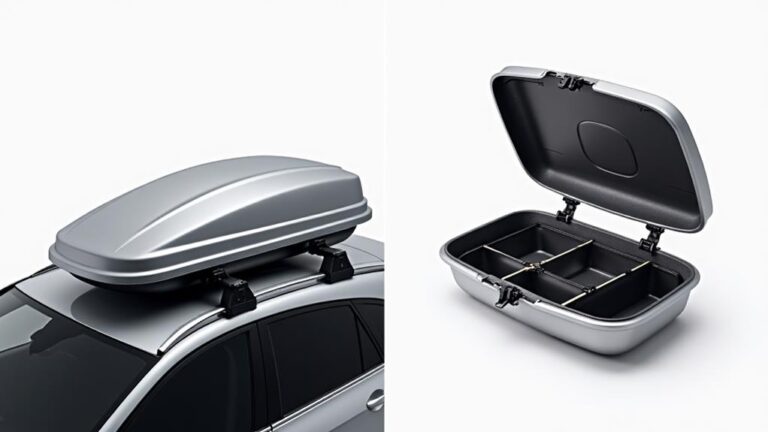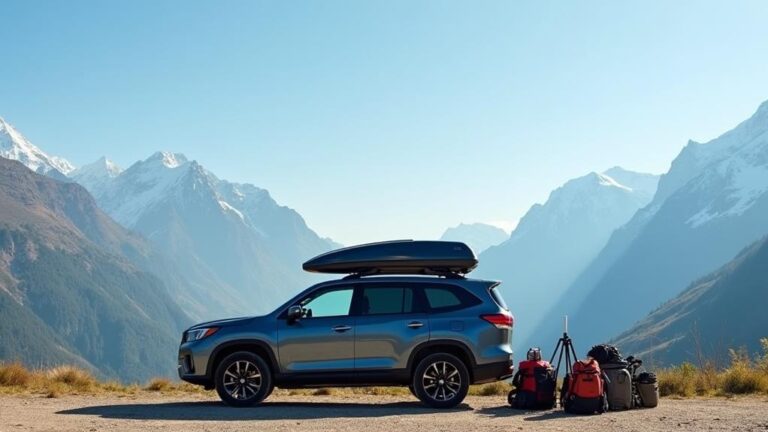Just as Sisyphus faced an eternal struggle pushing his boulder up a seemingly endless hill, you'll encounter your own series of uphill battles when traversing switchbacks on your next hike. These winding trails can test your endurance, but with the right approach, you'll be able to conquer them with ease. By understanding the design and layout of switchbacks, you'll be better equipped to tackle the challenges that lie ahead. But what specific strategies can you employ to make the most of your hike and stay safe on the mountain?
Key Takeaways
- Plan your route ahead with route mapping and topo analysis to visualize the trail's layout and anticipate challenging sections.
- Use trail markers in conjunction with a map and compass to stay oriented and on course while navigating switchbacks.
- Monitor surroundings, keeping a close eye on weather and terrain, and look for signs of changing weather patterns.
- Stay hydrated by drinking at least one liter of water per hour of hiking and replenish energy levels with electrolyte drinks and snacks.
- Use trekking poles to maintain balance and reduce fatigue, keeping them at a 45-degree angle and adjusting length to match the terrain.
Understand Switchback Trail Design
A typical switchback trail design consists of a series of connected, zigzagging paths that traverse steep slopes.
This design allows hikers to ascend or descend steep terrain with less difficulty, as it breaks the climb into shorter, more manageable sections. You'll notice that switchbacks often change direction at a sharp angle, usually around 90 degrees, which helps distribute the elevation gain more evenly.
The trail geometry of a switchback is carefully planned to minimize erosion and guarantee a safe passage for hikers.
By zigzagging across the slope, switchbacks reduce the risk of landslide and soil erosion. As you hike a switchback trail, pay attention to the elevation gain and how it's distributed along the trail.
A well-designed switchback trail will have a consistent elevation gain between each turn, making it easier for you to pace yourself and conserve energy.
Understanding the design principles behind switchback trails can help you navigate them more efficiently.
Plan Your Route Ahead
Your preparation begins with planning your route ahead, which can make all the difference when traversing switchbacks on a hike.
By taking the time to plan, you can gain valuable insights into the trail's terrain, including the location and frequency of switchbacks. Route mapping is essential in this process, as it allows you to visualize the trail's layout and anticipate challenging sections.
When mapping your route, consider incorporating Topo analysis to gain a deeper understanding of the trail's elevation changes and steepness.
This information will help you identify potential switchback sections and plan your approach accordingly. With this knowledge, you can adjust your pace, pack accordingly, and mentally prepare for the challenges ahead.
Additionally, route planning enables you to identify potential hazards, such as inclement weather or steep drop-offs, and plan your route to minimize risks.
By planning your route ahead, you'll be better equipped to handle the physical and mental demands of traversing switchbacks on your hike.
This preparation will ultimately contribute to a safer and more enjoyable hiking experience.
Follow Trail Markers Closely
Trail markers are the hiker's best friend when traversing switchbacks.
These markers are strategically placed to guarantee safe and efficient trail passage. When charting switchbacks, it's vital to follow trail markers closely to avoid confusion and misdirection.
Marker placement is carefully designed to guide you through the switchbacks and keep you on track.
Look for physical markers such as signs, posts, and blazes on trees.
Pay attention to the type of marker and what it indicates – for example, a sign with an arrow may indicate a turn, while a blaze on a tree may indicate the direction of the trail.
Check for markers at intersections and turns to guarantee you're heading in the right direction.
Take note of the frequency of markers – if you haven't seen a marker in a while, it may be a sign that you've gone off track.
Use trail markers in conjunction with your map and compass to stay oriented and on course.
Pace Yourself and Take Breaks
After traversing switchbacks with the help of trail markers, it's time to focus on your physical well-being.
Pace yourself and take breaks to avoid fatigue factors that can decrease your hiking performance. Fatigue can creep in due to the repetitive climbing and descending on switchbacks.
To combat this, monitor your energy levels and rest when needed.
When taking breaks, focus on your breathing techniques. Practice deep breathing exercises to help slow down your heart rate and recharge your muscles.
Inhale slowly through your nose, filling your lungs, and exhale slowly through your mouth. This technique can help alleviate stress and fatigue.
Take a moment to assess your body, stretching your legs and back to prevent muscle strain.
Stay Hydrated and Energized
Hiking switchbacks requires sustained energy levels, making it essential to stay hydrated and energized throughout the hike.
You'll want to bring snacks and drinks that provide a boost of energy and replenish lost electrolytes. Aim to drink at least one liter of water per hour of hiking, depending on the weather and your individual needs.
To stay hydrated and energized, consider the following:
- Bring electrolyte drinks, such as sports drinks or coconut water, to replenish lost electrolytes.
- Pack energy chews or trail mix with nuts and dried fruits to provide a quick energy boost.
- Avoid consuming too much caffeine or sugary snacks, which can lead to energy crashes.
- Eat snacks regularly, rather than waiting until you feel hungry or tired.
- Monitor your body's hydration levels by checking the color of your urine: if it's dark yellow or amber, drink more water.
Use Trekking Poles Wisely
When traversing switchbacks, you'll want to use trekking poles to your advantage.
To get the most out of your poles, you'll need to choose the right ones for your hike, taking into account factors like terrain, weight, and durability.
Choosing the Right Poles
Trekking poles can be a valuable companion on a switchback-heavy hike, but to reap their benefits, you need to choose the right pair for your needs.
When it comes to pole selection, consider the type of hiking you'll be doing most often. If you're tackling rugged terrain or long distances, a sturdy, durable pole is a good choice.
For lighter, shorter hikes, a lighter pole may be sufficient.
When choosing a pole, consider the following key factors:
- Grip material: Look for poles with grips made from comfortable, sweat-resistant materials like cork or foam. Avoid poles with hard or slippery grips that can cause discomfort or accidents.
- Pole weight: Lighter poles are ideal for shorter hikes, while heavier poles provide more stability on long or rugged hikes.
- Pole length: Consider poles with adjustable lengths to accommodate different hiking styles and terrain.
- Tip material: Carbide or steel tips provide durability and traction on various surfaces.
- Shock absorption: Poles with shock-absorbing technology can reduce fatigue and discomfort on long hikes.
Adjusting Pole Length Properly
Now that you've chosen the right pair of poles for your hike, it's time to adjust them to fit your needs.
Proper pole adjustment is vital for efficient and comfortable hiking. When your poles are the right length, you'll be able to maintain good posture and avoid fatigue.
To adjust your poles, start by standing up straight with your arms relaxed at your sides. Then, adjust the length of your poles so that your elbows are at a 90-degree angle when you hold the grips. This will guarantee proper fitting and help you maintain balance on uneven terrain.
When adjusting your poles, make sure to ponder the type of terrain you'll be hiking on. For example, you may want to shorten your poles for steep inclines and lengthen them for flat or downhill sections.
Keep in mind that pole adjustment may vary depending on the type of pole you're using. Refer to your pole's manufacturer instructions for specific guidance on how to adjust the length of your poles.
Using Poles for Balance
To tackle switchbacks with confidence, you'll need to master the art of using poles for balance.
Using trekking poles wisely can be a game-changer on uneven terrain. By adjusting your pole angle and grip, you can markedly improve your stability and agility.
When traversing switchbacks, it's vital to adjust your pole angle to match the incline.
This will help you maintain your balance and prevent your poles from slipping. Additionally, selecting the right grip material can make a big difference in your overall comfort and control. Look for grips made from durable, moisture-wicking materials that can withstand various weather conditions.
Keep your poles at a 45-degree angle to maintain balance and prevent slipping.
Adjust your pole length to match the terrain, keeping your elbows slightly bent.
Use your poles to help with propulsion and balance, not just for support.
Keep your weight centered over your feet, with your poles on either side.
Practice using your poles on various terrain types to build your confidence and skills.
Monitor Weather and Terrain
When traversing switchbacks while hiking, you should constantly assess your surroundings, keeping a close eye on the weather and terrain.
Mountain forecasts can be unpredictable, and conditions can change rapidly. Check forecasts before you start your hike, but also monitor the weather as you climb.
Look for signs of changing weather patterns, such as increasing wind, dropping temperatures, or darkening skies.
In addition to monitoring the weather, pay attention to trail conditions. Switchbacks can be particularly hazardous when the trail is wet, icy, or loose.
Be aware of any obstacles on the trail, such as rocks, roots, or low-hanging branches. If the trail conditions are hazardous, consider turning back or finding an alternative route.
It's also essential to stay aware of your surroundings as you hike. Keep an eye out for potential hazards, such as loose rocks or steep drop-offs.
Frequently Asked Questions
How to Handle Loose Rocks on Switchback Trails?
When hiking on rocky terrain with steep inclines, you'll likely encounter loose rocks. To handle them, you'll need to slow down and carefully place your feet on stable ground, using trekking poles if needed.
Can I Take Shortcuts on Switchback Trails Safely?
When considering shortcuts on trails, you must weigh risks and trail etiquette. A shortcut mentality can lead to erosion and disruption of the ecosystem, so it's generally not recommended to take them, prioritize the main trail instead.
How Do I Navigate Switchbacks With a Heavy Backpack?
When hiking with a heavy pack, you'll need to adjust your footwork and maintain a steady pace. Distribute pack weight evenly and keep your center of gravity low to avoid losing balance on uneven terrain.
What if I Encounter Wildlife on Switchback Trails?
When encountering wildlife on trails, you'll want to prioritize safety, especially in bear country. Make noise, keep a clean campsite, and stay alert. If you see wildlife, stay calm and give it plenty of space to pass.
How to Descend Switchbacks With Trekking Poles Safely?
You'll descend steep terrain like a tightrope walker, requiring balance and poise. When using trekking poles, focus on strategic pole placement and even weight distribution to guarantee stability and maintain your center of gravity.
Conclusion
As you conquer switchbacks, remember that 'pride comes before a fall.' Don't let fatigue or overconfidence cloud your judgment. By understanding switchback design, planning ahead, following trail markers, pacing yourself, staying hydrated, using trekking poles, and monitoring weather and terrain, you'll be well-equipped to tackle even the most formidable trails. Stay vigilant, stay safe, and your hiking experience will be one to remember.












